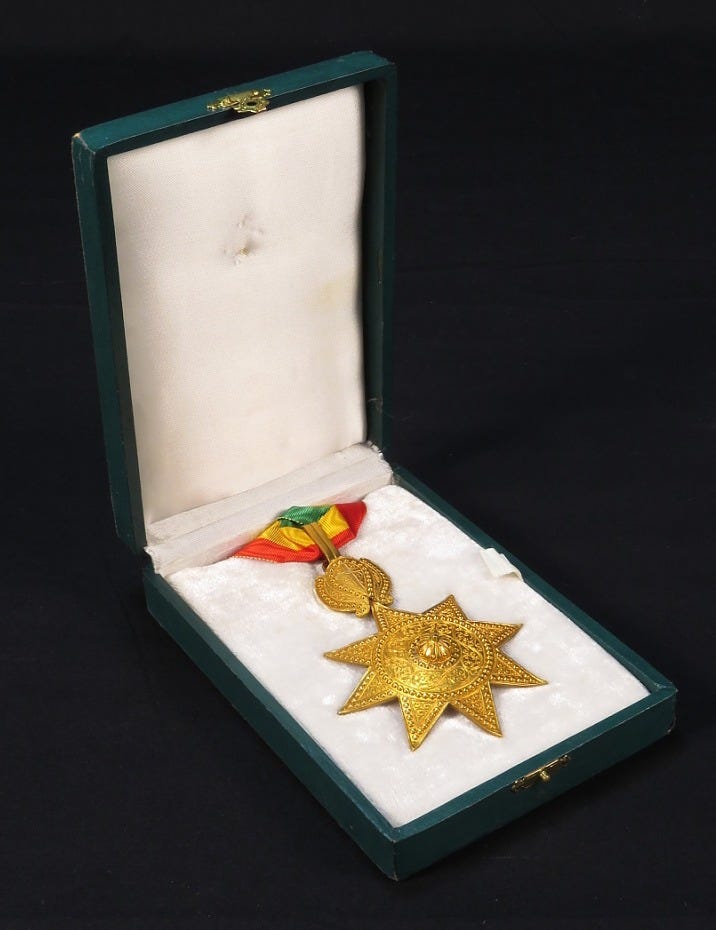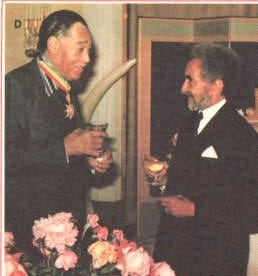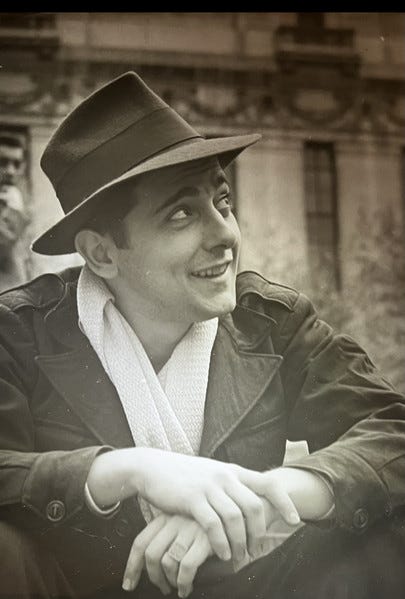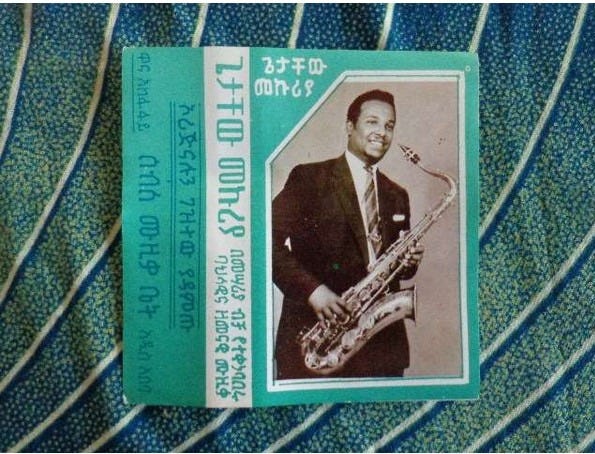Ethio-jazz
Summer is coming...
It took me over two years to put this thing together. So putting the four modes and building the world on top of that four modes. And that’s the science of Ethio-jazz. It’s not only that, but Ethio-jazz is like a music which puts the whole world together.
-Mulatu Astatke
Éthiopiques 4: Ethio Jazz & Musique Instrumentale 1969-1974, the 1998 compilation that kick-started a renaissance of Ethiopian jazz musician Mulatu Astatke and Ethio-jazz, features Astatke with Duke Ellington on the cover.
Ellington and his Orchestra were on their last European tour in late 1973. Before returning to the United States, the U.S. State Department arranged performances for the group in Africa, including one in Addis Ababa, Ethiopia. The embassy assigned Astatke to be Duke’s escort.
While he was there, Emperor Haile Selassie presented Ellington with Ethiopia’s Medal of Honor:
Here is Ellington talking with Emperor Haile Selassie after receiving the medal:
It’s amazing to think that only two years later, on August 27, 1975, Selassie was murdered by military officers of The Derg. This military dictatorship ushered in an era of political turmoil and repression in Ethiopia. After The Dreg regime was overthrown in 1987, the modern era of Ethio-jazz began, reintroducing artists who were silenced or forced to leave during the regime’s reign.
An important part of that reintroduction was the French record Buda Musique, which in 1997 released a series of CDs beginning with Éthiopiques 1 - Golden Years Of Modern Ethiopian Music 1969-1975.
This week on that Big River called Jazz we’ll dig in our paddles and explore the world of Ethio-jazz.
Ras Teferi visited Jerusalem in 1924. While there, he was entertained by music played by orphan Armenian boys who had lost their parents in the 1918 Armenian Genocide. He offered to take some boys to Ethiopia to form a marching band. Ras Teferi took forty of them. They became known as the Arba Lijoch, which means the “40 children” in Amharic, the official language in Ethiopia. Ras Tafari arranged for the musical education of the youths, and they became the royal imperial brass band of Ethiopia:
Arba Lijoch’s band leader was Kevork Nalbandian. He was also orphaned in the Armenian genocide. On November 2, 1930, when the crown prince Ras Teferi became Emperor Haile Selassie I, Nalbandian performed the national anthem he composed called Tereri Marsh, Ethiopia Hoy (Ethiopia, Be Happy), which remained the national anthem until 1975.
Nalbandian subsequently led Arba Lijoch as the Ethiopian National Orchestra. The success of the group eventually led to a music renaissance.
When Nalbandian retired, his nephew Nerses Nalbandian took over as the head of the group. When Emperor Selassie commissioned him to compose music for the Ethiopian National Theatre, he began to fuse traditional Ethiopian music and Western instrumentation. This is considered the basis for the evolution of Ethio-jazz, which was further developed by Mulatu Astatke.
Astatke was born in western Ethiopia in 1943. He studied aeronautic engineering in North Wales in the late 1950s and classical music at Trinity College in London, where he played with many leading British jazz musicians. Fascinated with jazz, he attended Berklee College of Music in Boston in 1958. He moved to New York City in the 1960s to further develop his idea of Ethio-jazz.
In 1966, as The Ethiopian Quintet, he recorded two terrific Afro-Latin Soul albums released on Worthy Records, a short-lived independent jazz label founded in Brooklyn by American producer Gil Snapper:
I think it’s interesting to use three versions of the same song to show the development of Ethio-jazz over time. The first version of Mascaram Setaba (Summer is Coming) is from Afro-Latin Soul Vol 1:
In 1972, again on Worthy Records, Astatke recorded Mulatu of Ethiopia. With this record, he started to perfect his new sound. From that album, here is a more Ethio-jazz version of Mascaram Setaba:
And here is another version of Mascaram Setaba from To Know Without Knowing, a collaboration with the Australian group Black Jesus Experience, released in 2019 on the German Agogo label:
From the second 1966 Afro-Latin Soul volume, here is Raina, with the nice James Bond vamp into:
Astatke was in New York City during the mid-‘60s at the same time as Hugh Masekela, Miriam Makeba, and Fela Kuti, and all played an important part in putting Africa on the contemporary jazz map.
Another powerhouse in the Ethio-jazz world is Gétatchèw Mèkurya. Sometime in the early 1970s, he released this excellent cassette:
You can listen to the cassette here:
He was praised for the work on his album The Negus (King) of Ethiopian Sax when it was released in 2004, which contained his most popular song, Muziqa heywété:
Hailu Mergia and The Walias Band’s Tezeta (1975) and Tche Belew (1977) are two more stone-cold classics. I can’t say which I like better.
Tezeta (Nostalgia) was originally produced on a homemade cassette in 1975 before it was reissued by Awesome Tapes From Africa in 2021. The first three songs on the Tezeta are priceless, but the title track is sublime:
His Tche Belew is an equally killer album:
From Tche Belew, here is the title track, which reminds me a little of Phil Cohran and the Ethnic Heritage Ensemble:
The Walias Band was formed in the early 1970s in Addis Ababa and was the house band for the upscale Hilton Hotel:
During that time, a civilian curfew made it dangerous for visitors to leave after 11:00 PM. Therefore, the band played up to three sets until 6:00 AM the next morning. From the same album, here is the wonderful Yemiasleks Fikir:
Here’s one more for the road. Ethio-jazz was featured in Jim Jarmusch’s 2005 film Broken Flowers, which starred Bill Murray:
The Film’s score was composed by Mulatu Astatke, and he uses music built around four of his compositions. Here are two of the songs he featured. The first is Yèkèrmo Sèw (I’m Sorry) from a 1969 EP released on the B-side by Amha Records, an Ethiopian record label established by Amha Eshete in 1969:
The second is Gubèlyé (My Gubel) from Astatke’s second album, released in 1974, also on Amha Records:
Ethio-jazz intertwines the improvisational spirit of jazz with Ethiopia's distinctive musical traditions, and, like that Big River called Jazz, it is deep and wide. This week, we only paddled down the main channel. Many side channels and backwaters await the curious listener…
Next week on that Big River called Jazz, we’ll dig our paddles into the waters of the 00 Corvette Special.
Please hit this link to buy me a cup of coffee, if you’d like to show your guide some appreciation for this and past journeys. Know in advance that I thank you for your kindness and support.
If you like what you’ve been reading and hearing so far on our journey and would like to share this with someone you think might be interested in learning more about our great American art form: Jazz, just hit the “Share” button.
From Astaire to Sun Ra: A Jazz Journey is a reader-supported publication. If you feel so inclined, subscribe to my journey by hitting the “Subscribe now” button.
Also, find my playlist on Spotify: From Fred Astaire to Sun Ra.
Feel free to contact me at any time to talk shop. I welcome and encourage that.
Until then, keep on walking….











I didn't see a mention of Emahoy Tsegué-Maryam Guèbrou the Ethiopian composer/pianist and nun. Her life story is amazing. The Guardian did a profile on her and recordings are available.
https://en.wikipedia.org/wiki/Emahoy_Tsegu%C3%A9-Maryam_Gu%C3%A8brou
https://emahoytsegemariamgebru.bandcamp.com/album/souvenirs
As usual, i never have time to fully dive into this— but! I have a lot of these ethio jazz collections, and the way you lined up different versions to show the development of these sounds is VERY helpful. I tend to just soak the stuff up, and seeing you lay the progression out is fascinating— it’s helping my understanding of grooves. This is good because i can literally use this improved understanding in my music and my teaching.